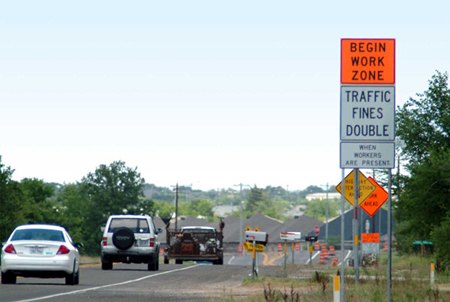Canada: Court Throws Out Speeding Tickets in Workerless Work Zones
According to a Winnipeg, Canada court ruling issued last month, “work zone” speed camera tickets are invalid if they are issued in an empty work zone. Judicial Justice of the Peace Norman Sundstrom tossed citations issued to nine defendants who traveled through workerless work zones without exceeding the normal speed limit for the road they were on. The decision was based on a nuanced reading of the interplay between the provincial photo radar law and the law governing construction zone warning signs.
Manitoba law authorized the use of photo enforcement “in construction zones.” A separate provision of the highway act described how temporary signs must be posted to indicate a drop in speed limit from, for example, 80km/h (50 MPH) to 60 km/h (37 MPH). The latter provision explicitly stated that such signs are to be used “while workers are present or using equipment in the construction zone.” Sundstrom argued that ticketing when workers were not present defeated the fundamental goal of the work zone safety law.
“The purpose . . . in my opinion is ultimately to protect workers by setting out rules to follow,” Sundstrom reasoned. “In these cases I find that sections 95(1.2) and 77(7.1b) show a clear clear intention on the part of the legislature to allow reduced speed signs in construction zones to be in effect ‘when workers are present’ and not otherwise.”
None of the nine photo ticket recipients had exceeded the road’s ordinary speed limit of 80km/h when they drove past empty work zones. The prosecution had argued that the 60km/h sign should be treated as a normal speed limit sign and that drivers should prosecuted for disobeying it. The work zone statute, prosecutors insisted, must be interpreted as protecting not just workers but drivers in general.
“The position taken by the crown here clearly seems to offend the general principle that there should be a consistent interpretation and enforcement of the law,” Sundstrom concluded. “In my opinion the rule as set out in 95(1.2) will apply to any prosecution for speeding that occurs in construction zones, and that any reduced speed sign that was placed there essentially to make the zone safer for workers—is enforceable only when workers are present.”
While legislation allowing photo radar in construction zones is commonly promoted as a measure to protect highway workers, the data show that the driving public rarely causes injury to highway workers. Larry Stefanuik, a former police constable who now helps motorists fight traffic tickets, asked the Workers Compensation Board of Manitoba for the latest data on injuries in construction zones caused by motor vehicles. He found very few were caused by cars.
Number of highway worker injuries in Manitoba caused by automobiles
“The high majority of collisions occurring in construction zones in Canada, involve vehicles belonging to the construction companies or their employees,” Stefanuik wrote.
Manitoba accident data are consistent with work zone statistics from the US which show that most work zone fatalities are actually caused by construction vehicles.
[ Click here for the full text of Sundstrom’s decision]
More by The Newspaper
Latest Car Reviews
Read moreLatest Product Reviews
Read moreRecent Comments
- Bkojote @Lou_BC I don't know how broad of a difference in capability there is between 2 door and 4 door broncos or even Wranglers as I can't speak to that from experience. Generally the consensus is while a Tacoma/4Runner is ~10% less capable on 'difficult' trails they're significantly more pleasant to drive on the way to the trails and actually pleasant the other 90% of the time. I'm guessing the Trailhunter narrows that gap even more and is probably almost as capable as a 4 Door Bronco Sasquatch but significantly more pleasant/fuel efficient on the road. To wit, just about everyone in our group with a 4Runner bought a second set of wheels/tires for when it sees road duty. Everyone in our group with a Bronco bought a second vehicle...
- Aja8888 No.
- 2manyvettes Since all of my cars have V8 gas engines (with one exception, a V6) guess what my opinion is about a cheap EV. And there is even a Tesla supercharger all of a mile from my house.
- Cla65691460 April 24 (Reuters) - A made-in-China electric vehicle will hit U.S. dealers this summer offering power and efficiency similar to the Tesla Model Y, the world's best-selling EV, but for about $8,000 less.
- FreedMike It certainly wouldn't hurt. But let's think about the demographic here. We're talking people with less money to spend, so it follows that many of them won't have a dedicated place to charge up. Lots of them may be urban dwellers. That means they'll be depending on the current charging infrastructure, which is improving, but isn't "there" yet. So...what would help EV adoption for less-well-heeled buyers, in my opinion, is improved charging options. We also have to think about the 900-pound gorilla in the room, namely: how do automakers make this category more profitable? The answer is clear: you go after margin, which means more expensive vehicles. That goes a long way to explaining why no one's making cheap EVS for our market. So...maybe cheaper EVs aren't all that necessary in the short term.


































Comments
Join the conversation
Good point Frizzlefry, you can also get the navalert device through our site, especially if you already have a built in gps nave unit in your car. The Navalert is just a small black box, it already has the fixed cameras for all north america installed and you can download common speed trap locations for mobile units or police radar. Larry www.trafficticketguru.com
Installing cams in construction zones don`t do much for the safety of workers, because they install barriers along the length of the sites. This is a case for the collection of the revenue nothing more.